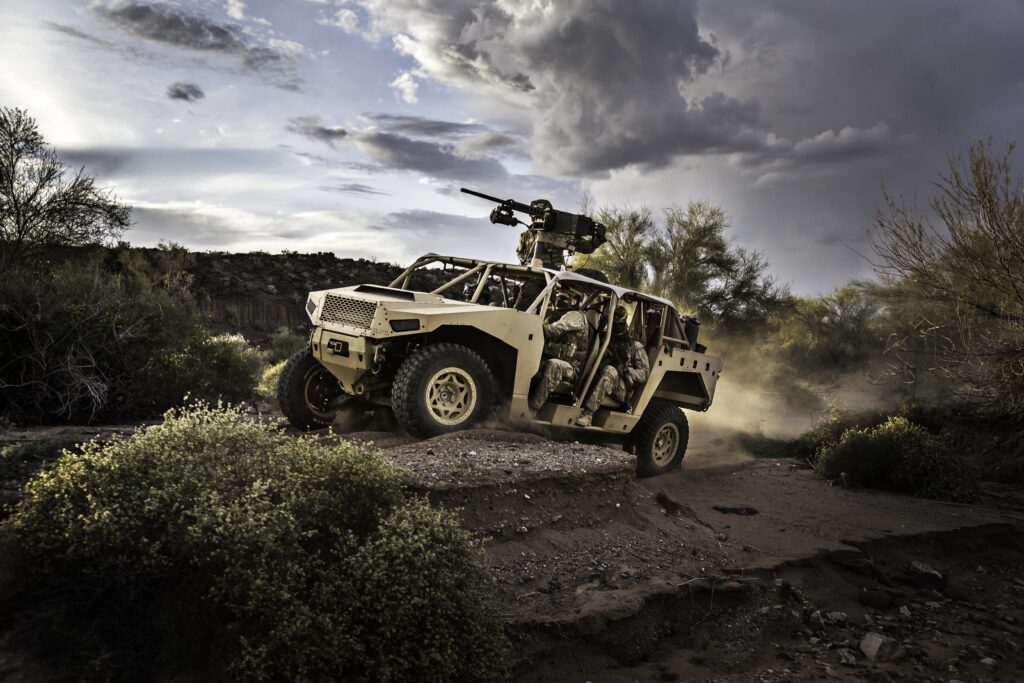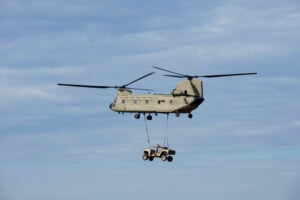Trucks From The Sky: Polaris Pitches DAGOR For ULCV
Posted on

Polaris DAGOR
On Monday, truck makers will submit data to the Army on potential candidates for the Ultra-Light Combat Vehicle. ULCV has to be big enough to carry nine fully equipped infantrymen, small enough to sling-load under a UH-60 Black Hawk helicopter, and tough enough to parachute out the back of a C-130 or C-17.
UCLV is the first of what’s intended as a trio of vehicles for the 82nd Airborne’s Global Response Force and, eventually, other light infantry units. (By contrast, the much better armored Joint Light Tactical Vehicle will be used Army-wide). The unarmored, nine-man ULCV will be followed by a lightly armored six-man Light Reconnaissance Vehicle and a well-armed light tank called the Mobile Protected Firepower system.

DAGOR sling-loaded under a CH-47 Chinook.
The objective is to provide a dash of mobility, long-range scouting and fire support to units that mostly move on foot. An Airborne unit with ULCVs could airdrop into a remote location far from enemy forces, mount up, and race cross-country to seize an airfield for reinforcements to fly into. This kind of capability is crucial to the Army’s quest to become more expeditionary, deployable and responsive after 13 years of static counterinsurgency.
One of the leading contenders for the ULCV is Polaris, which last year sold its DAGOR vehicle to US Special Operations Command. DAGOR can already carry a full nine-man squad. It already meets the weight and mobility requirements for ULCV, and it’s already been sling-loaded under helicopters and parachuted out of airplanes in official government tests, so Polaris plans to offer it for ULCV as-is.
Being such a known quantity is highly attractive to a cost-conscious Army buyer on a tight schedule. But Polaris is hardly the only competitor with a track record. General Dynamics will probably offer its Flyer, which won SOCOM’s Ground Mobility Vehicle (GMV) 1.1 competition. The Hendricks Dynamics Commando is also in US military use, as is Boeing’s beautifully named Phantom Badger, in service with undisclosed special operators. Vyper Adamas has sold its Vyper vehicles to the military, although not the exact model it’s offering for ULCV. In fact, of the six vehicles demonstrated last summer at Fort Bragg, home of the Airborne, the odd one out is aerospace giant Lockheed Martin’s High Versatility Tactical Vehicle, which derives from the British Army’s Jackal.
So what sets Polaris apart? “We came from the off-road business as opposed to the defense contractor business,” said Rich Haddad, general manager for Polaris Defense. Counting everything from one-person ATVs to RZR (“razor”) buggies, he said, Polaris has sold over one million off-road vehicles over the last five years. That’s a scale unheard of in the defense business.
The commercial marketplace also operates at a radically different pace than does Pentagon acquisition. “We change models every year,” said Haddad. “Imagine the headache you’d have with that in a program of record; you’d just be buried by the change orders.” But the commercial experience does help speed up the military side, he said: DAGOR went from “a piece of paper with a concept [to] for vehicles being tested at the NTC [National Training Center] in nine months.”
Because of Polaris’s commercial experience, Haddad boasted, “we’ve been through this process more times than you can imagine, and we’ve had more successes and failures than all of our competitors combined.”
Subscribe to our newsletter
Promotions, new products and sales. Directly to your inbox.
